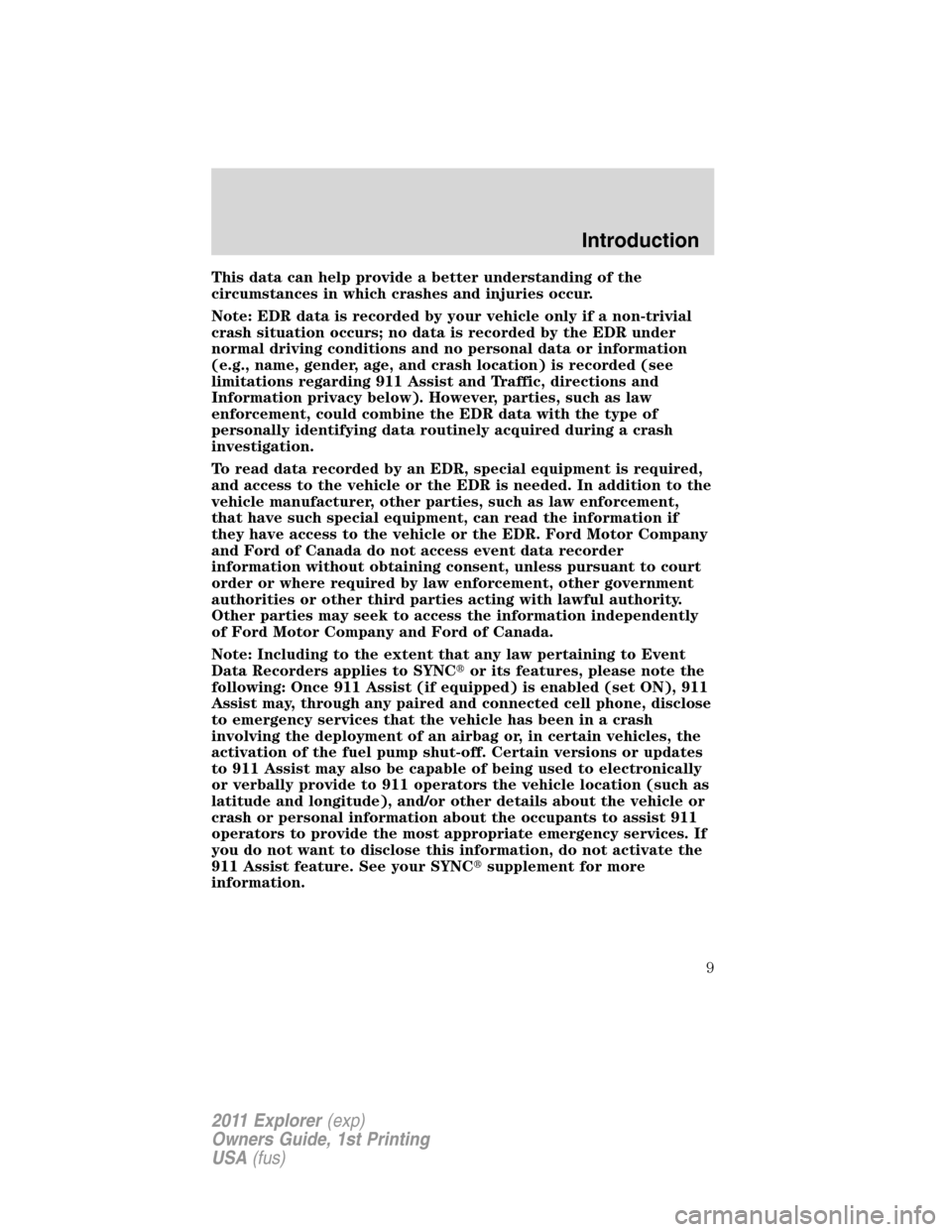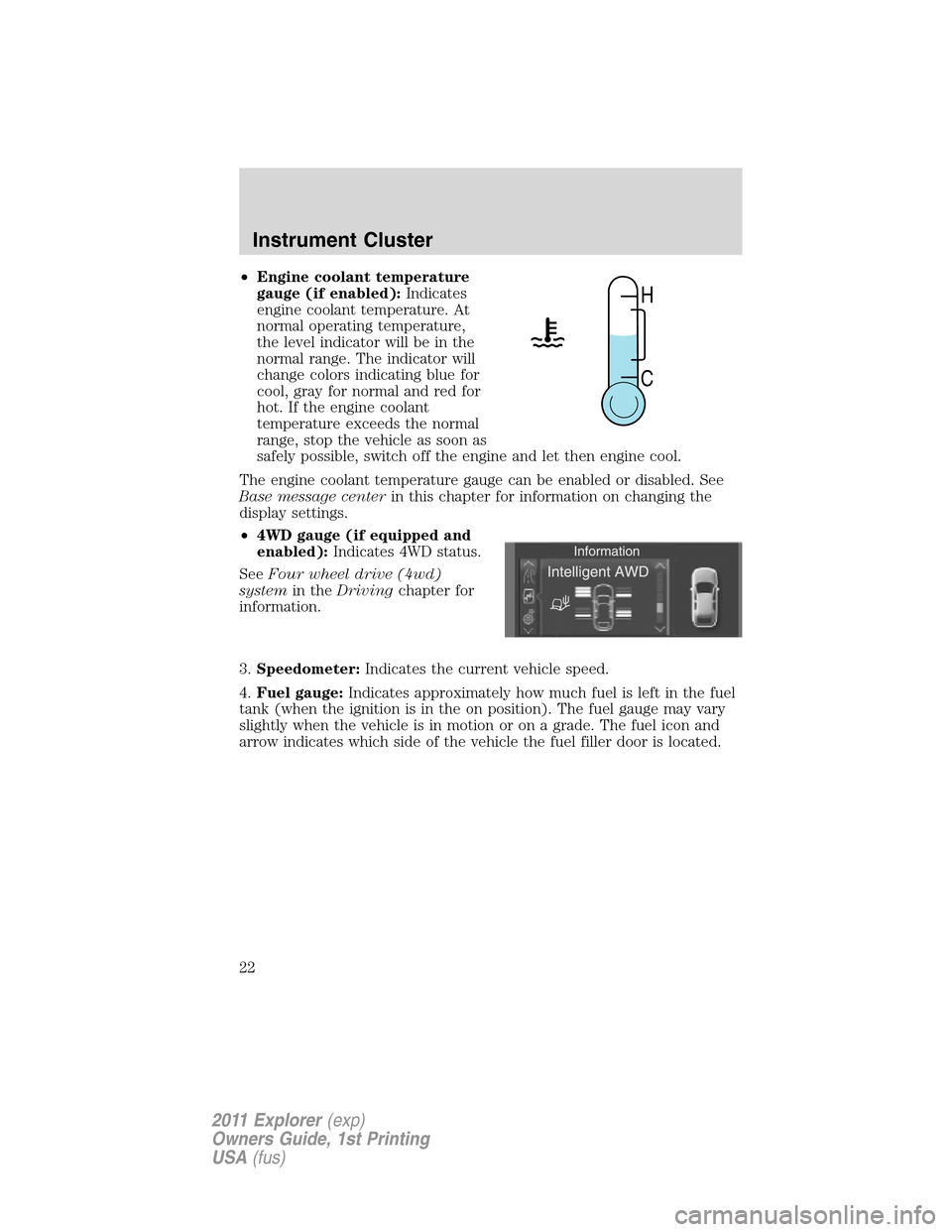Page 3 of 449
Seating and Safety Restraints 160
Seating 160
Personal Safety System™ 180
Safety belt system 184
Airbags 197
Child restraints 211
Tires, Wheels and Loading 232
Tire information 235
Tire inflation 237
Tire Pressure Monitoring System (TPMS) 250
Vehicle loading 255
Trailer towing 262
Recreational towing 265
Driving 267
Starting 267
Brakes 274
AdvanceTrac�277
Hill descent control 283
Transmission operation 288
Reverse sensing system 294
Rear-view camera system 296
Roadside Emergencies 325
Getting roadside assistance 325
Hazard flasher control 326
Fuel pump shut-off 327
Fuses and relays 327
Changing tires 336
Temporary mobility kit 344
Wheel lug nut torque 352
Jump starting 354
Wrecker towing 357
Table of Contents
2
2011 Explorer(exp)
Owners Guide, 1st Printing
USA(fus)
Page 4 of 449
Customer Assistance 359
Reporting safety defects (U.S. only) 366
Reporting safety defects (Canada only) 366
Cleaning 367
Maintenance and Specifications 375
Engine compartment 377
Engine oil 380
Battery 382
Engine coolant 385
Fuel information 392
Air filter(s) 406
Part numbers 410
Maintenance product specifications and capacities 411
Engine data 414
Accessories 417
Ford Extended Service Plan 419
Scheduled Maintenance Guide 423
Normal scheduled maintenance and log 429
Index 442
All rights reserved. Reproduction by any means, electronic or mechanical
including photocopying, recording or by any information storage and retrieval
system or translation in whole or part is not permitted without written
authorization from Ford Motor Company. Ford may change the contents without
notice and without incurring obligation.
Copyright © 2010 Ford Motor Company
Table of Contents
3
2011 Explorer(exp)
Owners Guide, 1st Printing
USA(fus)
Page 10 of 449

This data can help provide a better understanding of the
circumstances in which crashes and injuries occur.
Note: EDR data is recorded by your vehicle only if a non-trivial
crash situation occurs; no data is recorded by the EDR under
normal driving conditions and no personal data or information
(e.g., name, gender, age, and crash location) is recorded (see
limitations regarding 911 Assist and Traffic, directions and
Information privacy below). However, parties, such as law
enforcement, could combine the EDR data with the type of
personally identifying data routinely acquired during a crash
investigation.
To read data recorded by an EDR, special equipment is required,
and access to the vehicle or the EDR is needed. In addition to the
vehicle manufacturer, other parties, such as law enforcement,
that have such special equipment, can read the information if
they have access to the vehicle or the EDR. Ford Motor Company
and Ford of Canada do not access event data recorder
information without obtaining consent, unless pursuant to court
order or where required by law enforcement, other government
authorities or other third parties acting with lawful authority.
Other parties may seek to access the information independently
of Ford Motor Company and Ford of Canada.
Note: Including to the extent that any law pertaining to Event
Data Recorders applies to SYNC�or its features, please note the
following: Once 911 Assist (if equipped) is enabled (set ON), 911
Assist may, through any paired and connected cell phone, disclose
to emergency services that the vehicle has been in a crash
involving the deployment of an airbag or, in certain vehicles, the
activation of the fuel pump shut-off. Certain versions or updates
to 911 Assist may also be capable of being used to electronically
or verbally provide to 911 operators the vehicle location (such as
latitude and longitude), and/or other details about the vehicle or
crash or personal information about the occupants to assist 911
operators to provide the most appropriate emergency services. If
you do not want to disclose this information, do not activate the
911 Assist feature. See your SYNC�supplement for more
information.
Introduction
9
2011 Explorer(exp)
Owners Guide, 1st Printing
USA(fus)
Page 13 of 449
These are some of the symbols you may see on your vehicle.
Vehicle Symbol Glossary
Safety Alert
See Owner’s Guide
Fasten Safety BeltAirbag - Front
Airbag - SideChild Seat Lower
Anchor
Child Seat Tether
AnchorBrake System
Anti-Lock Brake SystemParking Brake System
Brake Fluid -
Non-Petroleum BasedParking Aid System
Stability Control SystemSpeed Control
Master Lighting SwitchHazard Warning Flasher
Fog Lamps-FrontFuse Compartment
Fuel Pump ResetWindshield Wash/Wipe
Windshield
Defrost/DemistRear Window
Defrost/Demist
Introduction
12
2011 Explorer(exp)
Owners Guide, 1st Printing
USA(fus)
Page 14 of 449
Vehicle Symbol Glossary
Power Windows
Front/Rear
Power Window Lockout
Child Safety Door
Lock/UnlockInterior Luggage
Compartment Release
Panic AlarmEngine Oil
Engine CoolantEngine Coolant
Temperature
Do Not Open When HotBattery
Avoid Smoking, Flames,
or SparksBattery Acid
Explosive GasFan Warning
Power Steering FluidMaintain Correct Fluid
LevelMAX
MIN
Service Engine SoonEngine Air Filter
Passenger Compartment
Air FilterJack
Check Fuel CapLow Tire Pressure
Warning
Introduction
13
2011 Explorer(exp)
Owners Guide, 1st Printing
USA(fus)
Page 16 of 449

Many lights will illuminate when you start your vehicle to make sure the
indicators work. If any light remains on after starting the vehicle, refer to
the respective system warning light for additional information.
Note:Some warning lights are reconfigurable telltale (RTT) indicators.
These indicators display in the lower line of the message center near the
odometer reading. They function the same as a warning light but do not
display on startup.
Service engine soon:The service
engine soon indicator light
illuminates when the ignition is first
turned to the on position to check
the bulb and to indicate whether the vehicle is ready for
Inspection/Maintenance (I/M) testing. Normally, the service engine soon
light will stay on until the engine is cranked, then turn itself off if no
malfunctions are present. However, if after 15 seconds the service engine
soon light blinks eight times, it means that the vehicle is not ready for
I/M testing. See theReadiness for Inspection/Maintenance (I/M)
testingin theMaintenance and Specificationschapter.
Solid illumination after the engine is started indicates the on-board
diagnostics system (OBD-II) has detected a malfunction. Refer to
On-board diagnostics (OBD-II)in theMaintenance and Specifications
chapter. If the light is blinking, engine misfire is occurring which could
damage your catalytic converter. Drive in a moderate fashion (avoid
heavy acceleration and deceleration) and contact your authorized dealer
as soon as possible.
WARNING:Under engine misfire conditions, excessive exhaust
temperatures could damage the catalytic converter, the fuel
system, interior floor coverings or other vehicle components, possibly
causing a fire.
Powertrain malfunction/reduced
power (RTT):Illuminates when a
powertrain or an 4WD fault has
been detected. Contact your
authorized dealer as soon as possible.
Instrument Cluster
15
2011 Explorer(exp)
Owners Guide, 1st Printing
USA(fus)
Page 18 of 449

Charging system (RTT):
Illuminates when the battery is not
charging properly. If it stays on
while the engine is running, there
may be a malfunction with the charging system. Contact your authorized
dealer as soon as possible. This indicates a problem with the electrical
system or a related component.
Engine oil pressure (RTT):
Illuminates when the oil pressure
falls below the normal range, refer
toEngine oilin theMaintenance
and Specificationschapter.
AdvanceTrac�:Displays when the
AdvanceTrac�/Traction control is
active. If the light remains on, have
the system serviced immediately,
refer to theDrivingchapter for more information.
AdvanceTrac�off light:
Illuminates when
AdvanceTrac�/Traction control has
been disabled by the driver. Refer to
theDrivingchapter for more
information.
Low tire pressure warning:
Illuminates when your tire pressure
is low. If the light remains on at
start up or while driving, the tire
pressure should be checked. Refer
toInflating your tiresin theTires, Wheels and Loadingchapter. When
the ignition is first turned to on, the light will illuminate for 3 seconds to
ensure that it is working. If the light does not turn on or begins to flash,
contact your authorized dealer as soon as possible. For more information
on this system, refer toTire pressure monitoring system (TPMS)in
theTires, Wheels and Loadingchapter.
Low fuel (RTT):Illuminates when
the fuel level in the fuel tank is at
or near empty. Refer toFuel gauge
in this chapter.
OFF
Instrument Cluster
17
2011 Explorer(exp)
Owners Guide, 1st Printing
USA(fus)
Page 23 of 449

•Engine coolant temperature
gauge (if enabled):Indicates
engine coolant temperature. At
normal operating temperature,
the level indicator will be in the
normal range. The indicator will
change colors indicating blue for
cool, gray for normal and red for
hot. If the engine coolant
temperature exceeds the normal
range, stop the vehicle as soon as
safely possible, switch off the engine and let then engine cool.
The engine coolant temperature gauge can be enabled or disabled. See
Base message centerin this chapter for information on changing the
display settings.
•4WD gauge (if equipped and
enabled):Indicates 4WD status.
SeeFour wheel drive (4wd)
systemin theDrivingchapter for
information.
3.Speedometer:Indicates the current vehicle speed.
4.Fuel gauge:Indicates approximately how much fuel is left in the fuel
tank (when the ignition is in the on position). The fuel gauge may vary
slightly when the vehicle is in motion or on a grade. The fuel icon and
arrow indicates which side of the vehicle the fuel filler door is located.
H
C
Instrument Cluster
22
2011 Explorer(exp)
Owners Guide, 1st Printing
USA(fus)